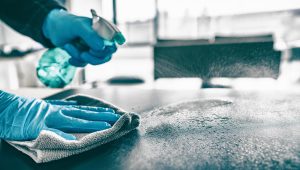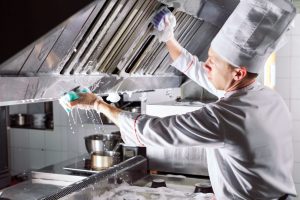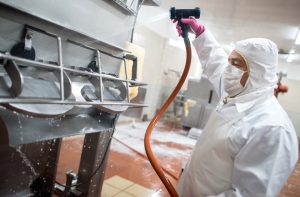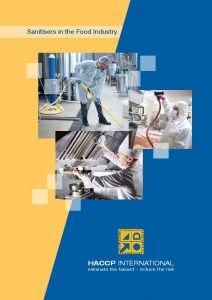 Sanitising food contact surfaces is an essential operation in food production where the control of microorganisms in the finished product is considered important. Sanitising involves the destruction of living micro-organisms on a surface through the use of an agent, typically heat, chemicals or a combination of both.
Sanitising food contact surfaces is an essential operation in food production where the control of microorganisms in the finished product is considered important. Sanitising involves the destruction of living micro-organisms on a surface through the use of an agent, typically heat, chemicals or a combination of both.
Sanitising is often mentioned at the same time as cleaning, ie Cleaning and Sanitising. But the first pitfall is understanding that sanitising cannot be effectively achieved without the first step of ‘cleaning’. Cleaning is the removal of food residues and biofilms from a surface. These coatings, often referred to as ‘soil’ present two problems in regard to sanitising. Firstly, they provide a medium for microorganisms to grow and multiply within. Secondly, they physically protect microorganisms from the kill effect of the sanitising agent. This applies to both heat and chemical sanitising. Ultimately, it is impossible to effectively sanitise an unclean surface. It is critical that all traces of soil and biofilms are removed in order to expose microorganisms to the sainting agent and to remove potential for microorganism growth.
Heat is commonly used as a sainting agent in warewashing applications where a hot water final rinse is delivered to the food contact surfaces at the end of a cleaning cycle. Temp and time are critical parameters in this case. An effective kill of microorganisms can only be achieved if an appropriate number of ‘heat sanitising units’ are applied to all food contact surfaces. These heat sainting units are a combination of temperature and time, if one parameter is not met, then the entire sanitising effectiveness can fail. In practical terms, the time and temperature should be measured using a data-logger system so that the parameters can be verified. Having fail-safe technology such as a system that will not start unless the temperature parameters are met is appropriate for this type of system. Another potential pitfall with such systems occurs when the hot water contact pattern does not effectively deliver the heated water to all areas of the food contact surface. This can occur through problems such as poor loading techniques, blocked spray nozzles or poor design of the warewashing unit itself.
Some sanitising operations also use hot air or steam to sanitise a food contact surface but these are less common and applied to specialised applications.
These days, chemical sanitisers are widely used in the food industry for the sanitising step on food contact surfaces. Chemical sanitisers have their own pitfalls and are not all created equally… it is recommended that chemical sanitisers only be purchased from suppliers where performance and applied food safety has been verified. The HACCP International certification scheme provides this assurance to end users.
In terms of food safety and elements to consider when using chemical sanitisers, the following matters deserve attention in order to achieve the best results;
- Ensure food will not be contaminated by storage or handling of the sanitiser chemicals.
Sanitiser chemicals, especially in concentrated form, may be considered toxic and may have objectionable odours and flavours associated with them. Safe storage of these products in a location where drips and spills will not contaminate food, ingredients or packaging is essential. Cross contamination to food contact surfaces must also be avoided especially during handling that may occur through decanting and dilution activities. Dedicated (and labelled) containers for measuring and diluting must be provided for these purposes and repurposed food containers should never be used. Staff handling these chemicals should be dressed in dedicated Personal Protective Equipment including wear.
- Consider the design parameters of the chemical, temperature, concentration in accordance with the manufacturer’s directions.
Sanitisers are designed to be used at specific concentrations, temperatures and sometimes chemical parameters such as pH. Using sanitisers outside of their designed and specified ranges can lead to reduced efficacy of the sanitiser. Following the manufacturer’s directions for use will ensure the best results. Automatic dispensing volumes must be routinely calibrated and verified to ensure the correct concentration is being delivered.
- Consider the contact time requirements of the chemical required for an effective kill
Sanitisers have a specific requirement for contact time in order to achieve a microbiological kill. The sanitiser manufacturers make these contact time requirements based on significant amounts of research. In particular, too short a contact time will result in reduced efficacy of the sanitiser. It is important that the chemical has physical contact time with the surface for the minimum specified contact time. To achieve this, the application format should be decided upon as discussed in the following point.
- Consider the application format of the chemical; dip, liquid spray or foam.
 Sanitisers can be applied in numerous ways depending on the equipment being sanitised. Immersion (dipping), spraying and foaming onto a surface are common application methods that each have their own benefits and drawbacks. These must be considered to ensure the most effective way of providing contact with all parts of the equipment for the desired contact time. CIP systems have their own specific requirements that must also be considered. As a guide, immersion, although impractical for large equipment, provides excellent control of contact time and the ability to provide contact into all areas (including those hidden) of the equipment. Foaming can extend contact times, particularly on vertical surfaces. Spraying (and fogging) can provide excellent coverage on large expanses of product contact surfaces or the manufacturing environment and, favourable ease of application.
Sanitisers can be applied in numerous ways depending on the equipment being sanitised. Immersion (dipping), spraying and foaming onto a surface are common application methods that each have their own benefits and drawbacks. These must be considered to ensure the most effective way of providing contact with all parts of the equipment for the desired contact time. CIP systems have their own specific requirements that must also be considered. As a guide, immersion, although impractical for large equipment, provides excellent control of contact time and the ability to provide contact into all areas (including those hidden) of the equipment. Foaming can extend contact times, particularly on vertical surfaces. Spraying (and fogging) can provide excellent coverage on large expanses of product contact surfaces or the manufacturing environment and, favourable ease of application.
- Ensure adequate contact with all parts of the equipment.
It is important that equipment to be sanitised not just what is considered to be food contact. Disassemble equipment to ensure contact with the chemical on surfaces paying particular attention to seals, inspection ports and penetration points on flat surfaces. Tight corners and fine gaps also should be eliminated by disassembling for effective sanitiser contact. Seals within pipework must be inspected and disassembled at appropriate intervals. The undersides of equipment and areas within guards must always be considered as these can commonly escape sanitising and easily re-infect the food stream and sanitised surfaces.
- Environmental Sanitising
One of the benefits of chemical sanitisers is the ability to be used in the broader manufacturing environment thereby potentially reducing the environmental microbiological loads in a food processing facility. Reduction of bacteria such as Listeria in certain food processing environments for example, can be a key element of the production of safe food. The design of the environmental elements such as drains can hinder the effectiveness of chemical sanitisers. For example, drainage systems are commonly designed not to run ‘full’, that is, pipes and causeways will only partially be filled under normal operating scenarios. Thus, in this example, achieving contact times and indeed contact at all with the entire surface of a drainage pipe may not be possible.
- Ensure appropriate levels of turbulence for in pipe CIP applications
In line turbulence is critical in ensuring appropriate cleaning via CIP of a pipework system. Appropriate levels of turbulence are delivered through in-pipe velocities of the cleaning chemicals. Laminar flows can result in incomplete cleaning and ineffective sanitation due to reduction of contact with remaining microorganisms.
- Ensure equipment delivers sanitiser to all surfaces especially where spray balls are utilised.
The delivery of chemical sanitisers via spray balls in applications such as tanks can be hindered where spray balls fail to deliver sanitising solution to all areas of the surface. This can occur due to poor spray ball design and running the system at less-than-optimal pressure. Shielding can also occur when parts of the equipment form a physical barrier between the spray ball discharge and the target surfaces. Examples of shielding have occurred from monitoring equipment such as temperature probes and agitation equipment located in the vicinity of a spray ball.
- Ensure pipework is free draining and dead legs have been eliminated.
The design of pipework is critical to ensure sanitising is effective and reduce the opportunity from cross contamination from the sanitiser chemical itself. Dead legs in pipework (sections of pipe that end) are impossible to clean and sanitise. The existence of dead legs in pipework will result in microbiological contamination of food. Pipework that is not free draining can hold quantities of sanitising chemicals and cross contaminate food with those residual chemicals when the line is restarted after sanitation.

- Rinse all traces of the sanitiser from equipment and surfaces using potable water unless using no-rinse chemical compounds.
Some sanitisers do not require rinsing from surfaces after use and some do. It is important to understand the usage requirements of the chemicals being used in this regard. Errors can (and have) occurred when sanitiser type is alternated to avoid microbiological resistance to a particular type of sanitiser in some applications. Rinsing of sanitisers from a surface must always involve the use of potable water of a suitable quality.
- Finally, ensure the sanitised equipment cannot be cross contaminated prior to food manufacturing operations recommence.
Once surfaces have been sanitised, great care must be taken to ensure these surfaces are not re-contaminated prior to the next scheduled use for food processing. Pests, human traffic, condensation and movements of food products have all been responsible for the recontamination of sanitised surfaces prior to scheduled use. Plant operators must consider these elements and have effective controls in place to avoid this scenario occurring.
Sanitising is a critical part of the safe food process where ever a reduced microbiological load on equipment is important. By failing to consider and verify the potential pitfalls as outlined above, sanitising operations can fail leading to increased microbiological loads, damage to product integrity and unsafe food.

Martin Stone
Technical Director
HACCP International
 Sanitisers in the Food Industry; A White Paper
Sanitisers in the Food Industry; A White Paper
In this document, we explore this key pillar of food safety in terms of performance criteria, correct usage, pitfalls and regulations.
A highly recommended read for everyone involved in the food industry, and there is no charge to download.
Click here to download Sanitisers in the Food Industry; A White Paper

